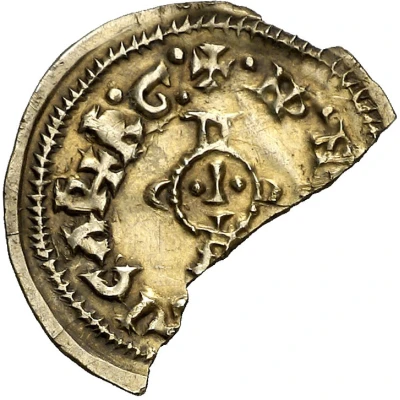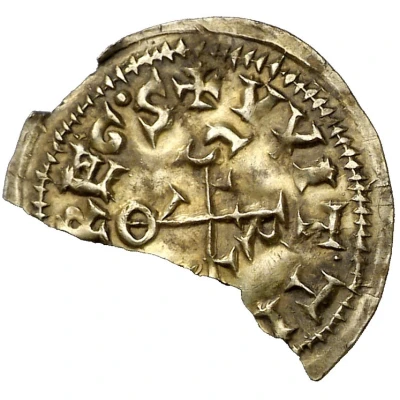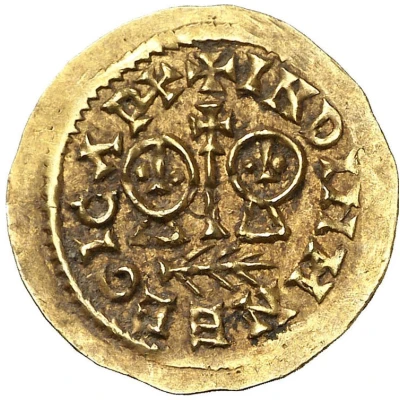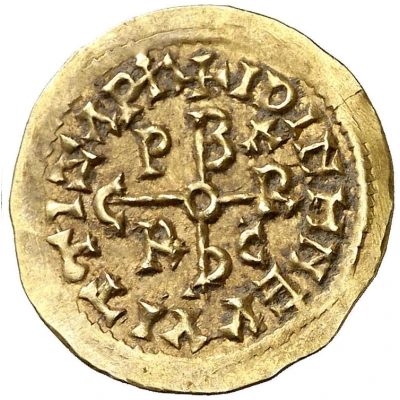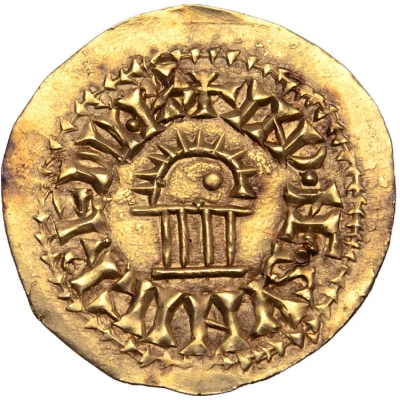
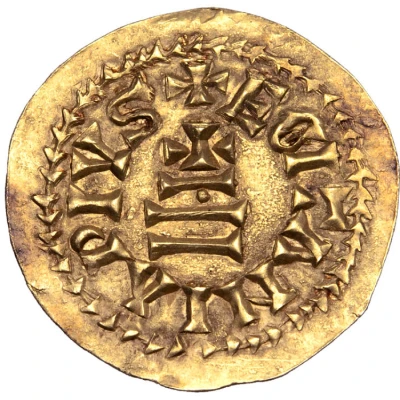

© Roma Numismatics Limited
Tremissis - Suniefred Egitania
| Gold | 1.32 g | 20 mm |
| Issuer | Visigothic Kingdom |
|---|---|
| Ruling authority | Suniefred (700-701) |
| Type | Standard circulation coin |
| Years | 700-701 |
| Value | 1 Tremissis |
| Currency | Tremissis |
| Composition | Gold |
| Weight | 1.32 g |
| Diameter | 20 mm |
| Shape | Round (irregular) |
| Technique | Hammered |
| Orientation | Medal alignment ↑↑ |
| Demonetized | Yes |
| Updated | 2024-10-04 |
| Numista | N#191488 |
|---|---|
| Rarity index | 100% |
Reverse
Cross potent on two steps; pellet between.
Script: Latin
Lettering: +EGITANIA PIVS
Comment
An unpublished type for a king of whom no other coins are known to survive, since the the example of the Madrid Museum was lost and presumed destroyed. The Madrid piece was first published by Arthur Engel in the Gazette Numismatique Française II, 1898, p.125 = G. Cirot, 'Un nouveau roi Wisigoth', in Revue des Études Anciennes (Annales de la Faculté des Lettres de Bordeaux), I, 1899, p. 168, = R. Mowat, 'Monnaie de Suniefred, Roi Wisigoth, découverte par M.A. Engel,' in RN 1899, pp. 102-3 = R. Mebéndez Pidal, Historia de España, Madrid 1928 p. 290 = Beltrán, Ampurias 1941, p. 103 = Miles 454 = Vico 554 (unique).Auctioned by Roma Numismatics Ltd, Auction XVIII 29 Sep 2019, Lot 1365, Sold for 120,000 GBP. From the property of a Gentleman, inherited in c.1970 from his grandfather, and kept in a drawer ever since.
"The mint of this unique coin is that of Egitania, modern Idanha-a-Velha, one of the oldest towns in Portugal, located in the region of Beira Baxa. Originally a Roman settlement (civitas Igaeditanorum), strategically located on the road which connected Emerita with Bracara, and later an episcopal seat of the Suebic kingdom depending upon Braga and present at its Council in AD 572. Following its incorporation into the Visigothic kingdom, it became dependent on the metropolis of Emerita in AD 666.
At least two rebels are known to history as having challenged royal authority in the reign of king Egica: Bishop Sisbertus and a leader called Suniefredus, but the chronology for their rebellions presents certain problems. The revolt headed by Sisbertus, the Metropolitan of Toledo, is well known, he conspired to assassinate Egica and other figures (Frogel, Theodomir, Liuvilana, Liuvigotona, Thecla and others), but the plot was discovered by the monarch who immediately imprisoned the conspirators. His actions were expressly condemned during the 16th Council of Toledo (AD 693), when Sisbertus was removed from his bishopric, excommunicated and sentenced to perpetual exile. However, a problem exists as to whether or not the lay leader of the rebellion was Suniefredus, as clergymen were legally unable to occupy the throne.
Little is known about Suniefredus, who apparently signed the protocols of the 13th Council of Toledo in AD 683 as "comes scanciarum et dux", but did not appear in subsequent convocations. If Suniefredus formed a part of Sisbertus' conspiracy, which was discovered before it was actually carried out, how was it possible for coins to have been struck in his name at Toledo and Egitania. Another unresolved problem, if Suniefredus was intended to become king, is why was he not cited in the condemnation of the conspiracy in the 16th Council of Toledo. These obstacles point to Suniefredus not being involved in Sisbertus's conspiracy, but that he was probably one of the powerful rivals at the end of Egica's reign, a period of epidemics, plagues and instability for which there is little information.
Suniefredus was presumably a provincial duke of high status who at some point early in 700 took control of at least the capital Toledo and Egitania, where he struck coins in his name as king. This temporary loss of the capital to the rebels seems to be corroborated by the fact that Egica enacted a law, dated in the 13th year of his reign in Cordoba (AD 700), inferring that the king had taken refuge in Cordoba during the rebellion, which was finally put down and of which we have no further details (Fuero Juzgo, Code of Laws, Book IX, Title I, Law XXI 'On the Serfs who flee'). " (source: Roma Numismatics Ltd, Auction XVIII Catalog)
Interesting fact
One interesting fact about the Tremissis - Suniefred (Egitania) coin is that it features a unique blend of Christian and pagan imagery. On one side, the coin bears the image of a cross, symbolizing the Christian faith of the Visigothic Kingdom. On the other side, it features a depiction of the Roman goddess Victory, highlighting the cultural influence of the Roman Empire on the Visigoths. This blending of religious symbols reflects the complex cultural and religious landscape of the time and adds to the historical significance of the coin.
